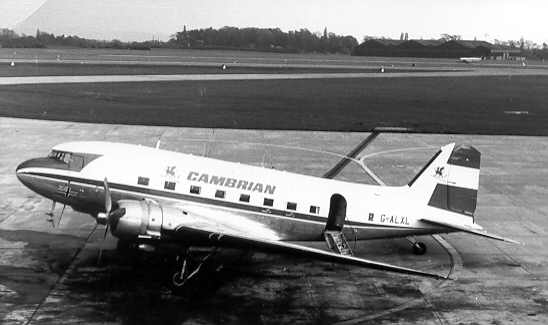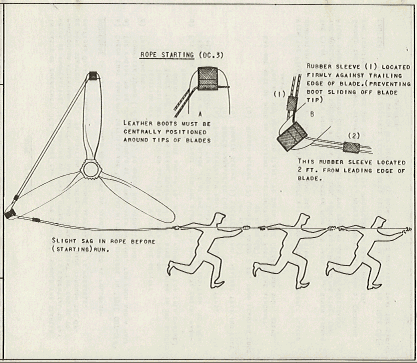
In this Section the DC-3 Propellors are examined, whether it be feathering' or running through the props by hand or rope, before starting the engines

Back in my early days in the USAF, my first two assignments were in C-47 aircraft after completing all-jet pilot training. During these six years (1962 to 1968), I accumulated nearly 3000 hours of flight time during which I experienced only two engine failures - one of which proved to actually be a prop feathering solenoid failure.
It was shortly after take-off when I noticed a thrust asymetry induced yaw and noted the number 2 engine RPM reducing. I assumed an engine failure and called for completion of the Engine Failure Checklist while I shut down the engine. To my amazement, after the engine went into full feather, it began turning again as the prop cycled out of feather on the dead engine. Fortunately, we were not much above traffic pattern altitude and we quickly returned to our take-off base (Chicage O'Hare Int'l Arpt).
On the post incident investigation, we found that the engine had not failed, but that the prop feathering solenoid located on the forward wheel well bulkhead just above the oil cooler had suffered an age related mechanical failure. This solenoid was a large electrical coil (about 2-1/2 inch in diam and about 3 inches tall) and was bolted to gether to the contacts with four long external screws running the lingth of the coil with the contacts at the top. The bakelight housing, through which the 4 lengthwise bolts passed, had cracked due to age and vibration, bringing the bolt in contact with one of the electrical leads, which in turn had fused the contact closed. The result was that the feathering motor was activated ON and was running continuously regardless of feathering switch position in the cockpit, thus continuously cycling the prop from cruise to full-feather and then back to unfeather, again and again. Needless to say. I subsequently made close examination of this solenoid a part of my pre-flight inspection.
Had I better understood the characteristics of the prop governor on a constant speed prop, I would have realized that a normal engine failure would NOT induce a significantly decreasing prop RPM as long as there was sufficient airspeed and the engine hadn't seized due to mechanical fault or lack of lubrication. Then I might not have been as quick to diagnose the problem as an engine failure. Although, getting it on the ground ASAP would still have been the proper procedure.
I subsequently participated on a fatal C-47 crash investigation off Nha Trang Vietnam in 1967. There were strong indications that that crash may have been the result of a similar prop feathering failure during slow flight orbit at night just offshore, of the AC-47 gunship.
Please remember that my comment about RPM decay was in reference to an inflight condition. My experience at the time were based upon the ground with engine checks. Certainly, at zero ground/air speed, or at the slow speed encountered during take-off acceleration, the RPM would decay with engine failure. But in flight, at or near cruise speed, the airflow over the props would cause the engine to windmill (regardless of whether they have paddle blade props or narrow props) and the prop governor would strive to remain the preselected RPM — and would be successful at doing so — provided the airspeed was sustained (above approx 100 mph) and the engine was mechanically capable of normal rotation.
I had this demonstrated by an instructor on a four engined DC-4 (C-54). In their pilot emergency drills, with a pilot under the IFR hood, he would reach up and switch off the mags on an inboard engine. An instrument scan would not reveal a dead engine until after several minutes the CHT and Oil Temp would start to decay. The only physical indication of the dead engine was the resulting thrust-loss yaw and slow airspeed decay. The engine RPM hardly even fluctuated with the engine cut.
Also, I once ran both engines dry of fuel and experienced this sustained RPM phenomenon there. The only obvious indication that the engines weren't running was the sudden silence.
Hope my "lessons learned" will prove valuable to present and future DC-3 crewmembers!
Chuck Miller

IN CASES OF EMERGENCY, DC3 ENGINES CAN BE ‘ROPE STARTED’, SHOULD THE
STARTER MOTOR BE INOPERATIVE. IN CARRYING OUT THIS OPERATION, IT IS
ESSENTIAL TO PAY PARTICULAR ATTENTION TO SAFETY AND PROCEDURE AND ALWAYS
START THE ENGINE TO BE ROPE STARTED, FIRST. IN ADDITION, A CHECK SHOULD
BE MADE THROUGH THE OPERATIONS OFFICE TO ENSURE THAT NO OPERATIONAL
ALTERNATIVE IS POSSIBLE.
PROCEDURE:- WITH THE APPROVED ROPE SLING ON HAND, PROCEED AS FOLLOWS:--
A) CHECK THAT IGNITION SWITCHES ARE 'OFF' AND MIXTURE CONTROL IN IDLE
CUT-OFF,
B) THE ENGINE TO BE STARTED SHOULD BE TURNED OVER BY HAND, FOR FOUR AND
A HALF COMPLETE TURNS (14 BLADES), TO CHECK FOR HYDRAULICING
C) PRIME ENGINE.
1) IGNITION OFF (2) MIXTURE IDLE CUT-OFF
3) THROTTLE SET (1/2 INCH ON GATE) (4) BOOSTER PUMP ON
5) WHILE THE ENGINE IS BEING TURNED BY HAND, GIVE PRIMING IN ONE SECOND
BURSTS (FOUR FOR HOT AND UP TO, PERHAPS, FOURTEEN FOR COLD ENGINE)
6) BOOSTER PUMP OFF.
D) FIT ROPE SLING. PLACE END BOOT OVER ONE BLADE TIP AND ROTATE ENGINE
BACK WARDS UNTIL THE FOLLOWING BLADE IS AT THE EIGHT O'CLOCK POSITION
AND THEN PLACE SECOND BOOT OVER THE TIP ENSURING THAT :-
A) BOOTS CENTRALLY POSITIONED AROUND BLADE TIPS.
B) ROPES PARALLELED (NO TWISTS)
c) RUBBER SLEEVE (1) LOCATED FIRMLY AGAINST TRAILING EDGE
OF BLADE (B)
D) RUBBER SLEEVE (2) LOCATED ABOUT 2 FT. FROM LEADING EDGE
OF BLADE (B)
LAY OUT REST OF ROPE IN STRAIGHT LINE TOWARDS THE PORT OF THE AIRCRAFT.
YOU ARE NOW READY TO START, TO CHECK 'All CLEAR' DOOR SHUT, STEPS AWAY
ETC.
WITH THE PILOT IN THE COCKPIT, MAN THE ROPE WITH, PERHAPS, THREE PEOPLE
PLACED
COMFORTABLY HOLDING THE ROPE WITH A SLIGHT SAG IN THE MIDDLE,
THE PILOT NOW SWITCHES IGNITION 'ON', BOOSTER PUMP 'ON' AND, AT A GIVEN
SIGNAL THE ROPE 15 PULLED THROUGH WITH A JERK AND, IMMEDIATELY THE
ENGINE FIRES THE PILOT OPENS THE MIXTURE CONTROL AND FLICKS THE PRIMING
SWITCH IF NECESSARY.
SHOULD THE ENGINE NOT START ON FIRST PULL, REPEAT PROCEDURES FROM D)
ENSURING THE IGNITION SWITCHES ARE 'OFF' WHILE THE PROPELLER IS BEING
HANDLED.
CAUTION:- To AVOID POSSIBLE FLOODING ETC.; RETURN MIXTURE CONTROL TO
‘IDLE CUT-OFF’ AND SWITCH OFF BOOSTER, AS SOON AS IT IS REALIZED THAT
THE ENGINE HAS NOT STARTED.
Serial No.7-2-1
Issued:6.1.66
As an old (no cracks, "Bear") RCAF Dakota Crewman, and then bench inspector on P&W round engines, I heartily endorse the proper pull-through of ANY round engine prior to start-up. The facts are there. If there is an oil build-up in the lower cylinders, there is the high
probability of a hydraulic lock when these cylinders go into the compression cycle.
In the old RCAF, we pulled the blades through at the start of every day's flying, and then again during the day if the engine had been shut down for any period of time. It was a pain in the neck, back and shoulders, but it paid off. When properly carried out, I don't remember EVER having to do an engine change because of hydraulic lock. When the aircraft was flown every day (as were our Navigation Trainer C47's), we used to pull through nine blades per engine. If the aircraft had sat for long periods, then we pulled through even more. It's even MORE important if you do an oil dilution prior to shut-down. One tip: wear gloves. It saves the hands. Don't forget, you're pulling on the trailing edge of each blade. Also, pull in a straight line in direction of rotation - don't try to pull the blade off the engine. (I saw one enthusiastic ground tech pull a big chunk out of the trailing edge of a wooden blade on a Avro Anson once. It would be tough to do on a Hamilton Standard, but it does prove a point.)
The technique used was to reach up and grab the trailing edge and pull it down toward yourself, then once the blade was vertical, to put your shoulder behind it and then keep following though with your hands until the blade was out of reach. Like I said, tough on the neck, back and shoulders, but worth it. It's easier than having to change a 1500 lb. engine.
Keep swinging those props. It's the right thing to do.
Bill Ewing aka ol' Sarg
Yes, it's a good idea to pull the prop through by hand
if a radial has not
been run for several days.
Oil seeping down into the lower cylinders produces what we call a "hydraulic
lock".
On a normal start, we count 12 blades with the starter before turning on the
mags.
On the R1830-75 we had electric primers and we'd get it stabilized with prime
before advancing the mixture.
Robert Campbell
I see the old question of "should I or shouldn't I pull
through my round engine" is still around. Believe me, it's cheaper to
spend a little time and some sweat than a lot of time, a lot of sweat, and a lot
of money to remove an engine, ship it in for an expensive overhaul and then have
to rehang it. In the RCAF, it was written that we WOULD pull-through a
round engine at the start of each flying day and even during the day, depending
on the temperature and how long the aircraft sat. For the R-1830 on the
C47 Dakota, it was nine blades IN THE DIRECTION OF ROTATION on each engine.
We did it on Dakotas, we did it on Mitchells, and we did it on Harvards....I
know they did it on Boxcars and other round engines, but I forget the exact
procedure there. After the RCAF, I was bench inspector on P&W R-985,
R-1340, & R-1830s. In every case where there was broken connecting
rods, split cylinders, or pulled studs, the chief culprit was hydraulic lock.
It's a fact of life, people. !
If you don't pull a round engine through, sooner or later, you will be paying
our big bucks to major overhaul your engine.
Bill Ewing aka ol' Sarg